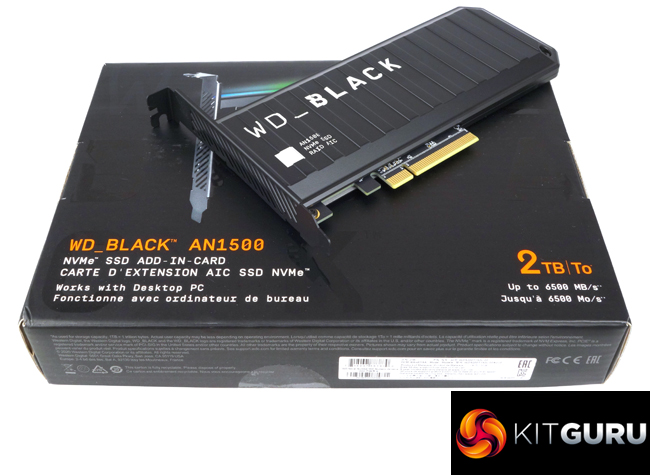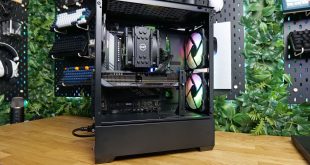WD's new Black AN1500 drive has been designed to cater for the needs of gamers/enthusiasts who are wanting a drive with PCIe Gen 4 levels of performance but are using a motherboard with only PCIe 3.0 architecture. There are three capacities of AN1500 currently available; 1TB, 2TB and the flagship 4TB drive.

To try and achieve their goal, WD has gone down the AIC (add-in-card) route. Sitting under the AN1500's aluminium top cover is a pair of WD's PC SN730 NVMe (96-Layer 3D TLC NAND) SSDs which are built into a RAID 0 hardware array, which is looked after by a Marvell 88NR2241 RAID controller. The drive uses a PCIe 3.0 x8 interface so it goes without saying that to get the full benefit of the AN1500 you need to make sure you have a PCIe 3.0 slot with 8 PCIe lanes free.
The drive has aluminium covers for both sides of the PCB to act as heatsinks, as with two fast NVMe SSDs and a RAID controller things can get rather toasty when the drive is being pushed.
WD quote Sequential read/write figures for the 2TB drive as up to 6,500MB/s and up to 4,100MB/s respectively. Incidentally, they are the same speeds for the 1TB and 4TB drives as well. Using the ATTO benchmarking tool (ver 4) we couldn't get to the maximum official rating, the tested drive producing a figure of 5,970MB/s. We got a bit closer with our own Sequential read test at 6,124MB/s. However, when tested with CrystalDiskMark 7 Peak Performance profile we could indeed confirm that official figure with a test result of 6,860MB/s. As for Sequential writes, we could confirm the official figure with all our tests. 4,526MB/s in CrystalDiskMark 7 Peak Performance, 4,550MB/s in ATTO and 4,431MB/s in our own tests.
The 2TB AN1500 is officially rated as up to 780,000 IOPS for random reads and up to 700,000 IOPS for random writes. We couldn't get close to these figures with our 4-threaded tests. The best read figure we saw was 421,556 IOPS (QD32) while the best write figure came at QD16 at 347,126 IOPS. We did a quick test using 8 threads at a QD of 32 and still came up short at 602,422 IOPS for reads and 532,202 IOPS for writes.
As with so many other bits of hardware these days, the AN1500 comes with RGB lighting. The lighting system uses 16 LEDs that sit behind a diffused cover that runs the whole length of the top of the drive and one side. The system is controlled by a page of WD's very good SSD Dashboard (version 3.1.25 supports the AN1500) drive management software. There are 13 basic pattern effects with options to fettle about with colour choice for most of them. The system is also compatible with MSI's Mystic Light Sync, Asus' Aura Sync and Gigabyte's RGB Fusion systems.
We found the 2TB WD AN1500 on Span.com for £568.80 (inc VAT) HERE
Pros
- Overall performance.
- WD SSD Dashboard software.
- 5-year warranty.
Cons
- Needs 8 PCIe lanes for full performance.
- Couldn't match official 4K figures under testing.
- Power consumption.
KitGuru says: WD's AN1500 delivers near PCIe 4.0 type performance for those people who are using PCIe 3.0 based systems and it comes in some useful capacities but it carries a hefty price tag.
 KitGuru KitGuru.net – Tech News | Hardware News | Hardware Reviews | IOS | Mobile | Gaming | Graphics Cards
KitGuru KitGuru.net – Tech News | Hardware News | Hardware Reviews | IOS | Mobile | Gaming | Graphics Cards



